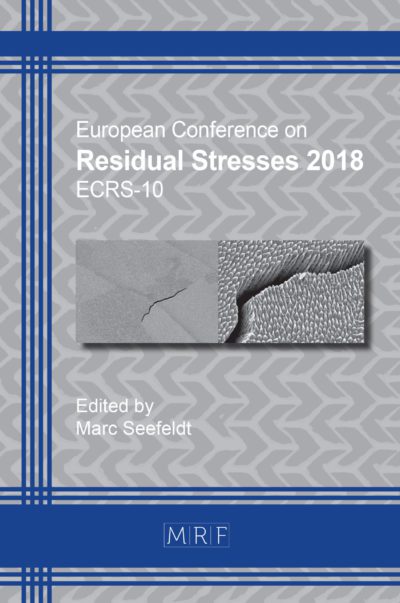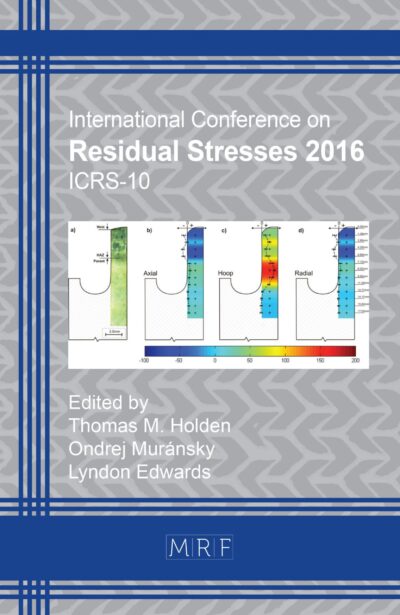Influence of milling parameters of powder DED Inconel 718 on cutting forces, surface roughness and temperature
Sylvain Etzol, Guillaume Altmeyer, Arnaud Duchosal
Abstract. The influence of milling parameters is studied on Inconel 718 produced through Direct Energy Deposition powder (DED). Variations of two cutting parameters, cutting speed and feed rate, are considered for three environments, dry, wet and Micro Quantity Lubrication (MQL). During milling machining, cutting forces and temperature are measured while surface roughness is evaluated afterward. The Specific Cutting Energy (SCE) and the temperature slope were then considered. To map a large enough experimental domain, while reducing the number of experiments, a Design of Experiments (DOE) is adopted to assess the parameter influences. Feed rate is the more critical parameter while cutting speed influence fluctuates more according to the environment. Wet lubrication clearly stands out for reducing both Specific Cutting Energy and surface roughness. Meanwhile, MQL generates similar roughness and Specific Cutting Energy to dry condition but decreases more efficiently temperature growth slope. Fz= 0.13 mm/tooth and Vc= 50 m.min-1 are critical parameters inducing extremum values for all the output parameters.
Keywords
End Milling Parameters, Inconel 718, Additive Manufacturing
Published online 5/7/2025, 10 pages
Copyright © 2025 by the author(s)
Published under license by Materials Research Forum LLC., Millersville PA, USA
Citation: Sylvain Etzol, Guillaume Altmeyer, Arnaud Duchosal, Influence of milling parameters of powder DED Inconel 718 on cutting forces, surface roughness and temperature, Materials Research Proceedings, Vol. 54, pp 1636-1645, 2025
DOI: https://doi.org/10.21741/9781644903599-176
The article was published as article 176 of the book Material Forming
![]() Content from this work may be used under the terms of the Creative Commons Attribution 3.0 license. Any further distribution of this work must maintain attribution to the author(s) and the title of the work, journal citation and DOI.
Content from this work may be used under the terms of the Creative Commons Attribution 3.0 license. Any further distribution of this work must maintain attribution to the author(s) and the title of the work, journal citation and DOI.
References
[1] Special Metal, ‘Inconel alloy 718’. [Online]. Available: www.specialmetals.com
[2] Aubert et Duval, ‘Alliage Base Nickel PER718’, Aubert et Duval. [Online]. Available: https://www.aubertduval.com/
[3] A. Kollová and K. Pauerová, ‘Superalloys – Characterization, Usage and Recycling’, Manufacturing Technology, vol. 22, no. 5, 2022, pp. 550–557. https://doi.org/10.21062/mft.2022.070
[4] P. Chevenard, ‘Alliage inoxydable, de très haute résistance mécanique, dénué de fragilité et conservant ses propriétés initiales malgré un séjour indéfini dans la vapeur surchauffée ou non, ou dans les gaz chauds et humides’, 1919, FR496930,
[5] P. Chevenard, ‘Procédé de traitement thermique des alliages à haute teneur en nickel et en chrome’, 1931, FR698724
[6] E. O. Ezugwu, Z. M. Wang, and A. R. Machado, ‘The machinability of nickel-based alloys: a review’, Journal of Materials Processing Technology, vol. 86, no. 1, Feb. 1999, pp. 1–16. https://doi.org/10.1016/S0924-0136(98)00314-8
[7] ‘Alliage base Nickel’, Lamineires Matthey SA., 2013, [Online]. Available: https://www.matthey.ch/home
[8] L. Norberto López de Lacalle, F. J. Campa, and A. Lamikiz, ‘Milling’, in Modern machining technology, Woodhead publishing, 2011, pp. 213–303.
[9] M. Alauddin, M. A. Mazid, M. A. E. Baradi, and M. S. J. Hashmi, ‘Cutting forces in the end milling of Inconel 718’, 1998, Journal of Materials Processing Technology.
[10] G. Mustafa, M. T. Anwar, A. Ahmed, M. Nawaz, and T. Rasheed, ‘Influence of Machining Parameters on Machinability of Inconel 718—A Review’, Adv. Eng. Mater., vol. 24, no. 10, 2022, p. 17. https://doi.org/10.1002/adem.202200202
[11] S. Roy, R. Kumar, Anurag, A. Panda, and R. K. Das, ‘A Brief Review on Machining of Inconel 718’, Materials Today: Proceedings, vol. 5, no. 9, 2018, pp. 18664–18673. https://doi.org/10.1016/j.matpr.2018.06.212
[12] A. Devillez, G. Le Coz, S. Dominiak, and D. Dudzinski, ‘Dry machining of Inconel 718, workpiece surface integrity’, Journal of Materials Processing Technology, vol. 211, no. 10, Oct. 2011, pp. 1590–1598. https://doi.org/10.1016/j.jmatprotec.2011.04.011
[13] W. Li, Y. B. Guo, M. E. Barkey, and J. B. Jordon, ‘Effect Tool Wear During End Milling on the Surface Integrity and Fatigue Life of Inconel 718’, Procedia CIRP, vol. 14, 2014, pp. 546–551.
[14] A.-L. Defretin and G. Levaillant, ‘Usinage à grande vitesse’, Technique de l’ingénieur, 1999.
[15] X. Wang, C. Huang, B. Zou, G. Liu, H. Zhu, and J. Wang, ‘Experimental study of surface integrity and fatigue life in the face milling of inconel 718’, Front. Mech. Eng., vol. 13, no. 2, Jun. 2018, pp. 243–250. https://doi.org/10.1007/s11465-018-0479-9
[16] J. Holmberg, A. Wretland, P. Hammersberg, J. Berglund, A. Suárez, and T. Beno, ‘Surface integrity investigations for prediction of fatigue properties after machining of alloy 718’, International Journal of Fatigue, vol. 144, Mar. 2021, p. 106059. https://doi.org/10.1016/j.ijfatigue.2020.106059
[17] V. K. Mamidi and M. A. Xavior, ‘A review on selection of cutting fluids’, Abhinav, vol. 1, no. 5, 2014, pp. 1–19.
[18] D. Kriebel et al., ‘A field investigation of the acute respiratory effects of metal working fluids. I. Effects of aerosol exposures’, Am. J. Ind. Med., vol. 31, no. 6, Jun. 1997, pp. 756–766. https://doi.org/10.1002/(SICI)1097-0274(199706)31:6<756::AID-AJIM13>3.0.CO;2-X
[19] P. Nowak, K. Kucharska, and M. Kamiński, ‘Ecological and Health Effects of Lubricant Oils Emitted into the Environment’, Int J Environ Res Public Health, vol. 16, no. 16, Aug. 2019, pp. 3002–3015. https://doi.org/10.3390/ijerph16163002
[20] K. Weinert, I. Inasaki, J. W. Sutherland, and T. Wakabayashi, ‘Dry Machining and Minimum Quantity Lubrication’, CIRP Annals, vol. 53, no. 2, 2004, pp. 511–537. https://doi.org/10.1016/S0007-8506(07)60027-4
[21] P. Merica, ‘Nickel alloy and method of making the same’, 1926, 1572744
[22] A. Choudhury, ‘State of the Art of Superalloy Production Application Using VIMIVARor VIM/ES’, ISIJ International, vol. 32, no. 5, 1992, pp. 563–574.
[23] N. Das, ‘Advances in nickel-based cast superalloys’, Transaction of the Indian Institute of metal, vol. 63, no. 2–3, 2010, pp. 265–274.
[24] M. Švec, P. Solfronk, I. Nováková, J. Sobotka, and J. Moravec, ‘Comparison of the Structure, Mechanical Properties and Effect of Heat Treatment on Alloy Inconel 718 Produced by Conventional Technology and by Additive Layer Manufacturing’, Materials (Basel), vol. 16, no. 15, Jul. 2023, p. 5382. https://doi.org/10.3390/ma16155382
[25] A. R. Balachandramurthi, J. Moverare, N. Dixit, and R. Pederson, ‘Influence of defects and as-built surface roughness on fatigue properties of additively manufactured Alloy 718’, Materials Science and Engineering: A, vol. 735, Sep. 2018, pp. 463–474. https://doi.org/10.1016/j.msea.2018.08.072
[26] C. Pei, D. Shi, H. Yuan, and H. Li, ‘Assessment of mechanical properties and fatigue performance of a selective laser melted nickel-base superalloy Inconel 718’, Materials Science and Engineering: A, vol. 759, Jun. 2019, pp. 278–287. https://doi.org/10.1016/j.msea.2019.05.007
[27] S. Periane et al., ‘Tool life and surface integrity characteristics in milling of SLM and C&W inconel 718 in dry and MQL condition’, The International Journal of Advanced Manufacturing Technology, 2022, pp. 647–659.
[28] S. Periane et al., ‘Selection of machining condition on surface integrity of additive and conventional Inconel 718’, Procedia CIRP, 2023, pp. 333–338.














